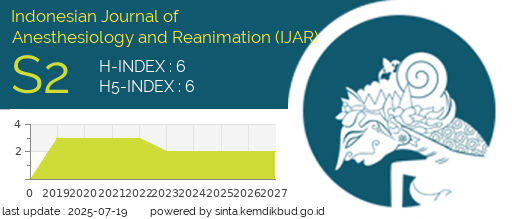Duration Of Ventilation Support Usage And Development Of Ventilator-Associated Pneumonia: When Is The Most Time At Risk?
Downloads
Introduction: Ventilator-Associated pneumonia (VAP) is pneumonia that occurs in patients who have been mechanically ventilated for a duration of more than 48 hours. The duration of ventilator use was identified as a risk factor which is a trigger of VAP. Objective: This study aimed to determine the association between the duration of ventilator use and the incidence of VAP in patients in the Intensive Care Unit of Dr. Mohammad Hoesin General Hospital, Palembang. Method and Material: This study was an observational analytic study using a cross-sectional design. The samples were all patients who use a ventilator for more than 48 hours at the ICU room period of July 1, 2014, to June 30, 2015. Data were obtained from the patient's medical records of a total of 146 patients, but the number of patients who comply with the criteria was 106 patients. Result and Discussion: Out of the 106 samples, 41 patients (38.7%) developed VAP and 65 patients (61.3%) did not develop VAP. The analysis using Chi-Square test showed that patients who used ventilator for >5 days had an OR = 3.273 compared to patients using ventilator 2-5 days (p-value = 0.016; 95% CI = 1.223 to 8.754). Conclusion: There is a significant association between the duration of ventilator use and the incidence of VAP in patients at the ICU of Dr. Mohammad Hoesin General Hospital, Palembang. Patients using ventilators for more than 5 days 3,386 times more at risk of developing VAP compared to patients using ventilators 2-5 days. The riskiest time for the patient using ventilator was more than 5 days of usage. And, the mortality rate of VAP patients was 63.4% from 41 patients while the mortality rate of whole ICU patients was 50.9%.
Amitai A. Ventilator Management. Medscape Reference (online). http://emedicine.medscape.com/article/810126-overview. 2013
Khan HA, Baig FK, Mehboob R. Nosocomial infections: Epidemiology, prevention, control and surveillance. Asian Pacific Journal of Tropical Biomedicine. 2017 May 1;7(5):478-82.
Mandell L, Woodhead M, Ewig S, Torres A. Respiratory Infections. Florida: CRC Press, 2006: 613.
Perhimpunan Dokter Paru Indonesia. Pedoman Diagnosis & Penatalaksanaan Pneumonia Nosokomial di Indonesia, 2003
Greene L, Sposato K. Guide to the Elimination of Ventilator-Associated Pneumonia. APIC, Washington, Amerika Serikat, 2009.
Stoelting I. Anesthesia and Co-existing Disease. Elsevier Inc, Philadelphia, Amerika Serikat, 2012: 478.
Cook DJ, Walter SD, Cook RJ, Griffith LE, Guyatt GH, Leasa D, dkk. Incidence of and risk factors for ventilator-associated pneumonia in critically ill patients. Ann Intern Med. 1998 Sep 15. 129(6):433-40.
Putri DS. Hubungan Antara Lama Penggunaan Ventilator Mekanik Dengan Kejadian Ventilator Associated Pneumonia (VAP) pada Pasien Nonsepsis di ICU RSUP Dr. Kariadi Semarang. Skripsi Sarjana. Jurusan Pendidikan Dokter Umum Fakultas Kedokteran, Universitas Dipenogoro, Indonesia, 2013.
Augustyn B. Ventilator Associated Pneumonia Risk Factors and Preventions (online). http://aacn.org/WD/CETests/Media/C0742. 2007.
Kollef M. Prevention of hospital-associated pneumonia and ventilator associated pneumonia. Crit Care Med 2004; 32:1396-405.
Cook DJ, dkk. Toward understanding evidence uptake: semirecumbency for pneumonia prevention. Crit Care Med 2002; 30:1472-7.
Safdar N, Dezfulian C, Collard H, dkk. Clinical and economic consequences of ventilator-associated pneumonia: A systematic review. Crit Care Med 2005; 33:2184–2193.
Muscedere JG, Day A, Heyland DK. Mortality, Attributable Mortality, and Clinical Events as End Points for Clinical Trials of Ventilator-Associated Pneumonia and Hospital-Acquired Pneumonia. Infectious Diseases Society of America 2010; 51:120-25.
Kalil AC, Metersky ML, Klompas M, Muscedere J, Sweeney DA, Palmer LB, Napolitano LM, O'Grady NP, Bartlett JG, Carratalí J, El Solh AA. Management of adults with hospital-acquired and ventilator-associated pneumonia: 2016 clinical practice guidelines by the Infectious Diseases Society of America and the American Thoracic Society. Clinical Infectious Diseases. 2016 Jul 14;63(5):e61-111.
Monteiro-Neto V, Lima-Neto LG, Abreu AG, Monteiro CR. Microbiology of Ventilator-Associated Pneumonia. InContemporary Topics of Pneumonia 2017 Dec 20. IntechOpen.
Koulenti D, Tsigou E, Rello J. Nosocomial pneumonia in 27 ICUs in Europe: perspectives from the EU-VAP/CAP study. European journal of clinical microbiology & infectious diseases. 2017 Nov 1;36(11):1999-2006.
Jovanovic B, Milan Z, Markovic-Denic L, Djuric O, Radinovic K, Doklestic K, Velickovic J, Ivancevic N, Gregoric P, Pandurovic M, Bajec D. Risk factors for ventilator-associated pneumonia in patients with severe traumatic brain injury in a Serbian trauma centre. International Journal of Infectious Diseases. 2015 Sep 1;38:46-51.
Chang I, Schibler A. Ventilator associated pneumonia in children. Paediatric Respiratory Reviews. 2016 Sep 1;20:10-6.
Copyright (c) 2019 Indonesian Journal of Anesthesiology and Reanimation

This work is licensed under a Creative Commons Attribution-ShareAlike 4.0 International License.
Indonesian Journal of Anesthesiology and Reanimation (IJAR) licensed under a Creative Commons Attribution-ShareAlike 4.0 International License.
1. Copyright holder is the author.
2. The journal allows the author to share (copy and redistribute) and adapt (remix, transform, and build) upon the works under license without restrictions.
3. The journal allows the author to retain publishing rights without restrictions.
4. The changed works must be available under the same, similar, or compatible license as the original.
5. The journal is not responsible for copyright violations against the requirement as mentioned above.


















